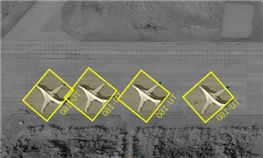
RUSSIAN bombers capable of carrying nuclear weapons have been spotted at an airbase near the Finland border, satellite images show.
Israeli intelligence firm ImageSat International detected an "irregular presence" of Russian TU-160 and TU-95 strategic bombers at the Olenya airbase.
According to the satellite images obtained by the Jerusalem Post, four TU-160s were seen at the base on August 21 and three TU-95s were seen on September 25.
But there were no strategic bombers at the airbase on August 12 – suggesting they were moved there recently, ramping up fears Putin could unleash nuclear Armageddon.
It's thought the bombers were moved to the base from the Engels airbase in southwest Russia – about 700km southeast of Moscow in the Saratov region.
ImageSat International said: "The system indicates that Engels air base is the possible departure point of the strategic bombers detected in Olenya airbase."
Read more on the Ukraine war
Drafted Russian rapper takes his own life telling fans ‘I’m not ready to kill’
NATO chief issues stark NUCLEAR war warning to madman Putin
The Engels airbase houses Russia’s only strategic bombers stationed near Ukraine, home to the 121st Heavy Bomber Aviation Regiment which flies the TU-160s and TU-95s.
The bombers are capable of carrying cruise missiles and strategic nuclear weapons – and have been active in the Ukrainian war since Putin's invasion in February.
It's not clear why the bombers have been moved to the Olenya base, which reportedly houses significant arms including nuclear weapons.
The airbase is also thought to be safely out of reach of the Ukrainian army.
Most read in News
Date of next general election REVEALED – and when it is might surprise you
Bills are high & people are scared but trust me – the Government is on your side
Soldier, 18, who walked alongside Queen's coffin during funeral found dead
Man charged with murder after student, 24, killed inside university halls
Since the Cold War era, Olenya has served as a deployment field for the Russian Air Force – and would have been a staging base for nuclear strikes on the US.
The mysterious movement of the bombers comes as Mad Vlad continues to threaten the West with the possibility of using nuclear weapons.
On Friday, he officially annexed four regions of Ukraine which cover about 15 per cent of the country – roughly the size of Hungary or Portugal.
The outrageous move has ramped up fears he could launch a nuclear strike to protect his so-called Russian territory.
As fierce Ukrainian forces push his troops back in the northeast of the country, there are concerns the tyrant will now try to reframe the lightning counteroffensive as an attack on Russia sovereignty.
The Kremlin said any attack on newly annexed parts of Ukraine will be considered an attack on Russia itself – adding his troops would fight to take the whole of the eastern Donbas region.
NATO issued a chilling nuclear war warning after Putin's deranged speech on Friday edged the world into the most dangerous moment since the Russian invasion.
Jens Stoltenberg, who heads the Western military alliance, said Putin's shameless landgrab would not stop NATO providing its "unwavering support" to Ukraine.
"Putin has mobilised hundreds of thousands of more troops, engaged in irresponsible nuclear sabre rattling and now illegally annexed more Ukrainian territory," Stoltenberg said.
"Together, this represents the most serious escalation since the start of the war.
Read More on The Sun
Find out how long you will live – based on 8 surprising factors
Where Hocus Pocus cast are now – shock firing to cannabis farmer and toxic feud
"NATO reaffirms its unwavering support for Ukraine's independence, sovereignty and territorial integrity.
"We remain resolute in providing support to Ukraine as it continues to defend itself against Russia's aggression, for as long as it takes."
Source: Read Full Article










